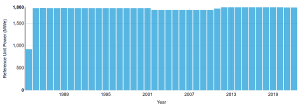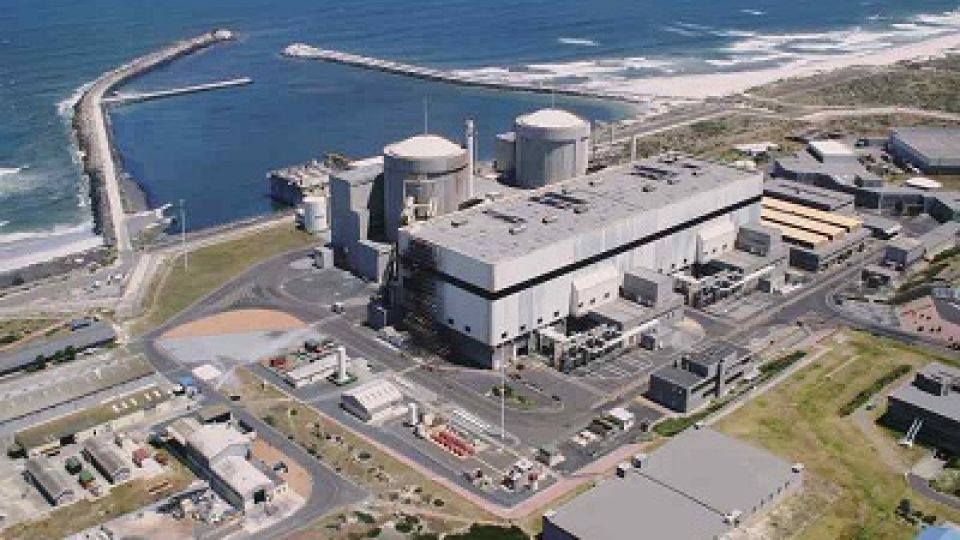CAPE TOWN, (CAJ News) – IN April 2024, South Africa will mark the 40th Anniversary of using nuclear power, while non-energy nuclear technologies have been around in the country since mid-1960s.
The Koeberg Nuclear Power Plant sets South Africa apart as the sole African country with the most advanced form of energy generation, at least for the time being.
As of today, nuclear power, specifically from Koeberg contributes around 5% of South Africa’s electricity needs, supplying half of the Western Cape grid. As seen on Graph 1 from the data collected by World Nuclear Association, Koeberg boasts an installed capacity of 1,860 megawatts and has operated successfully without any noteworthy incidents for four decades, with projections indicating its functionality at least until 2045 .

Graph 1
Graph 1. Operable nuclear capacity. World Nuclear Association. URL: https://www.world-nuclear.org/information-library/country-profiles/countries-o-s/south-africa.aspx
Since the launch of Koeberg-1 in 1984, numerous countries including Czech Republic, Iran, Mexico and Romania added nuclear power to their national energy mixes. The United Arab Emirates and Belarus are among the recent additions to this group. Despite varying economic development and financial positions, the majority of these nations have constructed more nuclear power units than South Africa.
Back in Africa, as we speak, Egypt is currently collaborating with the Russian nuclear power giant, Rosatom to construct a 4,000-megawatt power plant . Additionally, Ghana has announced a tender for a nuclear power plant. Various countries, including Burkina Faso, Mali, Burundi, Ethiopia and Zimbabwe have signed memoranda of understanding with Russia to explore nuclear energy for diversifying their energy sources.
Despite South Africa’s half-a-century experience with nuclear technologies, the country has not built nuclear power plants. In contrast, countries labeled as “nuclear newcomer” with less energy engineering experience have achieved success. The United Arab Emirates (UAE), for instance, completed their first power unit in approximately 7 years, with the entire four-unit power plant expected to be finished in 10 years . Three years ago, Johann Kritzinger, the Head of Leadership Effectiveness at Nawah Energy Company, shared on LinkedIn his pride in the collective achievements at Barakah Nuclear Power Plant. He specifically commended around 150 South African Nuclear Professionals for their contribution to the UAE, making it the 33rd country in the world with nuclear power generation . It is disheartening that while others celebrate energy industry milestones, South Africa commemorates 16 years of loadshedding.
South Africa’s public debate often examines the need to transition from coal, the predominant electricity source at around 72%, as per Eskom’s August 2021 Fact Sheet . This proportion is expected to remain relatively stable over the next decade, given the limited availability of viable alternatives to coal. South Africa holds its position as the world’s fifth-largest coal producer, generating an annual average of 224 million tons of marketable coal. Notably, 25% of this production is exported globally, securing South Africa’s position as the third largest coal exporter .

Graph 2
Graph 2. Total energy supply (TES) by source, South Africa 1990-2020. URL: https://www.iea.org/countries/south-africa
In the same Fact Sheet, Eskom also recognizes that environmental issues pose a significant challenge to coal as an energy source. The combustion of coal not only leads to air pollution but also the mining processes involved in extraction exert a substantial negative impact on the environment.
Mr. Fatih Birol, Executive Director of the International Energy Agency (IEA), emphasizes in his remarks on “Addressing Coal Emissions” that while coal power plants played a crucial role in global economic development, urgent action is required to cut down their greenhouse gas emissions . This is essential to drive a decline in global emissions and address a significant factor in climate change, calling for innovative solutions, substantial financial investments, and considerable political courage.
During the Coal Colloquium on February 1, 2022, at the Council for Geoscience Office, Mr. Gwede Mantashe, the Minister of Mineral Resources and Energy, acknowledged the significant challenges facing the coal mining industry, primarily due to its role in energy generation . He emphasised the interconnectedness of coal mining and power generation, urging mining companies to actively engage in discussions and contribute to exploring technologies for a transition to lower carbon emissions. “While committing to address climate change, it is crucial to consider South Africa’s abundant coal resources, its dependency on coal for baseload power and energy security, as well as the substantial economic and employment contributions of the coal industries”, said Minister Mantashe.
On the other hand, many climate change activists are pushing for an abrupt end to the fossil fuel era, simultaneously advocating for a transition to 100% renewable energy as a solution. However, many energy experts argue that because of their variability, renewable energy sources, specifically wind and solar cannot be the foundation of a dependable electricity grid.
This raises the question of finding solutions for African nations, where roughly 600 million people, about half the continent’s population, lack electricity access, and around 900 million lack access to clean cooking fuels and technologies . Providing the necessary space for industrialization and establishing a fundamental energy mix are crucial for these countries.
South Africa’s energy transition plan outlines the retirement of 39 gigawatts of coal power plants by 2035, posing challenges to national energy security as the addition of new generation capacity lags behind the decommissioning rate .
In this context, nuclear power stands out as the optimal choice, operating consistently to produce round-the-clock energy independent of weather conditions. Nuclear power is a reliable 24/7 energy solution, operating at around 90 percent capacity factor while emitting no carbon gases . With its remarkable energy density, even a small amount of nuclear fuel holds substantial energy, and its cost has shown stability over many years, if not decades.
Even Eskom openly acknowledges that incorporating nuclear power is a significant shift anticipated in global electricity production. It is worth mentioning that Koeberg Nuclear Power Plant offers the most affordable electricity in South Africa as per Eskom’s balance sheet.
Numerous studies in the USA have explored the possibility of converting coal power plant locations into nuclear sites, with a particular emphasis on small modular reactors (SMRs). The attention to SMRs stems from their compact size, occupying a limited area, their designed safety features, and their portability. Findings from these studies indicate that many Eskom coal sites align with International Atomic Energy Agency (IAEA) criteria for nuclear sites concerning population density and safety envelope, making them suitable candidates for conversion into SMR nuclear sites.
On the contrary, some of the South African environmentalists insist that nuclear power should not be a part of the energy mix. They claim that it is possible to shut down all the coal power plants and build solar and wind farms instead. However, such assertions can be misleading, as contemporary energy systems rely on a baseload source, such as coal or nuclear with intermittent sources like solar and wind as a compliment.
Critics of nuclear power often cite its purported high cost as a key argument. In 2017, the South African “nuclear deal” faced opposition primarily due to its cost. Organisations like SAFCEI and Earthlife Africa who are part of the anti-nuclear lobby groups strongly voiced concerns, deeming a “trillion rand” for 9,600 megawatts unacceptable . Even though the figure is not rooted in reality however, that is irrelevant for the current conversation.
Interestingly, the same people who opposed nuclear on the basis that it is “expensive” now advocate for the renewables-based Just Energy Transition Plan. However, this plan falls short, providing less than half of the 9,600 megawatts, yet it comes with a price tag ranging from 1.5 to 1.9 trillion rand . It is curious that some people advocate for a solution twice as costly, yet arguably ineffective in addressing the national energy crisis.
Had South Africa initiated the construction of a new nuclear power plant in 2016, it could have celebrated its “40th anniversary” with the inauguration of the first power unit. Sadly, instead, South Africa will be “mourning” many more years of loadshedding for the foreseeable future.
NB: Princess Mthombeni is Nuclear Communication Specialist and a Founder of Africa4Nuclear
– CAJ News

